|
|
|
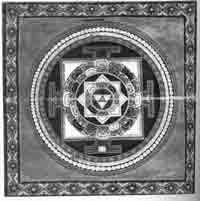
|
KUNDALINI
CHAKRAS - THE
ENERGY CENTRES |
|
|
| THIS IS THE
INTRODUCTORY CHAPTER ON CHAKRAS, AS DERIVED FROM VEDIC SCRIPTURES AND OTHER OLD
SCRIPTURES. A MORE ELABORATIVE AND SCIENTIFIC EXCPLANATION WILL BE GIVEN IN
FOLLOWING CHAPTERS
|
| The kundalini is like a Lotus. The increasing
number of lotus petals, in ascending order, may be taken to indicate the rising
energy or vibration frequencies of the respective chakras, each functioning as
a ‘transformer of energies from one potency to another. The Sanskrit letters
usually inscribed on the petals indicate sound-vibrations, and also represent
the varying intensities of the energies working in the different chakras
reflects is consonant with its vibration-frequency. Each chakra has its
approprite number or petals and corresponding colour: |
 |
|
|
|
Muladhara is represented as a red lotus of four
petals; Svadhisthana as a vermilion lotus of six petals; Manipura as a blue
lotus of ten petals; Anahata as a lotus of twelve petals of deep red colour ;
Visuddha as a lotus of sixteen petals of smoky purple; Ajna as a lotus of two
white petals; and lastly, Sahasrara is the thousand-petalled lotus of the light
of a thousand suns.
|
|
|
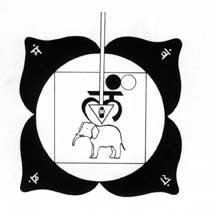 |
Muladhara, the root centre of physical
experience at the base of the spine, the sacral plexus, carries on each of its
four red petals a letter of the Sanskrit alphabet inscribe in shining yellow or
gold : va, sa, sa, sa. These letters are contained within a yellow square
representing the earth element, together with the seed mantra Lam. The four
letters represent the root vibration, and are related to the vital breath known
as Apana. |
|
|
| An inverted triangle in the centre
of the square encloses the unmanifest Kundalini in three and a half coils
around the black or red svayambhu-linga. In the pericarp is found the presiding
deity Brahma in deep red, four-faced three eyed, four-armed, holding a trident,
a libation jar, a rosary, and in Abhaya mudra, the gesture of dispelling fear.
The deity is the lord of the gross physical or material world. This
chakra is associated with the qualities of resistance and solidity representing
the earth element. |
|
| 2 Svadhisthana, the centre of whatever
constitutes the individual’s personality, situated in the spine in the region
above the gentails, carries on its six vermilion petal the six Sanskrit letters
ba, bha, ma, ya, ra, la. In the pericarp, the water element is represented by a
half-moon with the seed mantra Vam. The energy is Rakini or Chakini Sakti, in
dark blue, three-eyed, four-armed holding a trident, a lotus, a drum and a
chisel, seated on a red lotus.
|
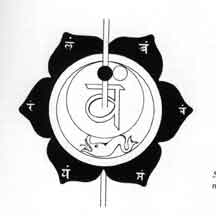 |
|
|
| The chakra’s associated animal is
the light grey or green makara (a sea-monster similar to the crocodile), an
emblem of the waters and the vehicle of the god Varuna, lord of the sea. The
chakra governs the principle of taste, and the vital breath prana.
|
|
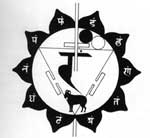 |
3 Manipura, the ‘gem-centre’ at the level of
the solar plexus, has on its ten blue petals the ten letters da, dha, na, ta,
tha, da, dha, radiant like the rising sun’, is related to the element fire. The
deity represents the world of mind. The energy generated by him is LakiniSakti,
in dark blue, three-faced three-eyed in each face, four-armed, holding fire,
vajra (thunderbolt), and making the gestures of graning boons and dispelling
fear.
|
|
|
| Patanjali in his yoga sutra (III,
29) says that contemplation of this chakra leads to knowledge of the physical
organism and its functions, because this is the chakra of the life-force.
The chakra is related to the principle of sight, and also to light, the upward
expansiveness of the fiery quality.
|
|
| 4 Anahata, meaning ‘unstruck’located at the
spinal centre of the region of the heart, has the twelve letters ka, kha, ga,
gha, na, ca, ccha, ja, jna, ta, tha, inscribed on its twelve vermilion or deep
red petals. The deity represents the whole world system in which the
diversities of phenomenal realities of space and time are gradually revealed.
His energy is called the Kakini Sakti in shining yellow, single-faced,
three-eyed, four-armed, holding a noose and a skull, and making the gestures of
granting boons and dispelling fear. The chakra is associated with the element
air and the principle of touch. |
 |
|
|
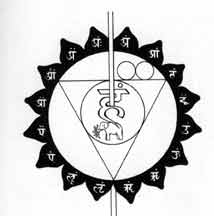 |
5 Visuddha, meaning ‘pure’ is located at the
juncture of the spinal column and medula oblongata behind the throat (laryngeal
plexus). Its sixteen smoky-purple petals bear the sixteen vowels a, a, i, i, u,
u, r, r, l, l, e, ai, o, au, am, ah. Within its percarp is a white circle and a
triangle inscribed with the seed mantra Ham. The presiding deity is Sadasiva as
Ardhvanarisvara (his androgynous aspect); the right half of the body is white
representing Siva and the left half is golden representing Sakti.
|
|
|
| The deity is five-faced,
three-eyed, holding a trident, an axe, a sword, a vajra (thunderbolt), fire
Ananta Serpent, a bell a goad and a noose, and is making the gestures of
dispelling fear. The energy is Sakini, in shining white five-faced, three-eyed,
four-armed holding a noose, a goad a bow and arrow. The chakra is associated
with the element ether (akasa) and controls the principle of sound related to
the sense of hearing. |
|
| 6 Ajna, meaning ‘command’, situated between the
eyebrows, controls the various states of concentration realized through
meditation, and commands one’s whole personality. Its two white petals bear the
letters ha and ksa. At the centre is an inverted moon-white triangle, and
within it the Itara-linga with the seed mantra Om. |
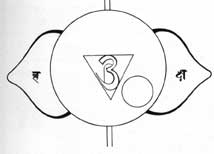 |
|
|
| Its deity is Paramasiva, as in the
Sahasrara; he is represented in this chakra in the form of a bindu, symbolizing
the inseparable Siva-Sakti the cosmic unity whose self-luminous consciousness
is all-pervading, all-transcending and all-unifying. His energy is called
Hakini or siddhakali, and is moon-white, six-faced, three-eyed, six-armed,
holding a book, a skull, a drum, a rosary, and making the gestures of granting
boons and dispelling fear, seated on a white lotus.
This chakra is associated with various cognitive
faculties of the mind. Both mental images and abstract ideas are experienced at
this level. Here for the first time undivided, indivisible existence manifests
for the sake of creation as two. Though Ida and pingala nadis separate from the
Sushumna channel at the Muladhara chakra they meet the sushumna in the region
of Ajna chakra and then again they separate, running into the left and right
nostrils.
|
|
| 7 Sahasrara, meaning ‘thousand’ is the lotus of
the thousand petals’ located four finger-breadths above the crown of the head.
Also called Brahma-randhra, it is the meeting place of Kundalini Sakti and
Siva. The petals bear the total sound-potential represented by all the letters
of the Sanskrit alphabet, fifty in each layer.
The chakra synchronizes all colours, encompasses
all senses and all functions, and is all-pervading in its power. The form is
the circle transcending various planes in ascending order, and finally,the
ultimate state of Mahabindu, the suprecosmic and metacosmic transcendental
void. The inverted lotus symbolizes the showering of the subtle body with
cosmic radiations. The sahasrara is the centre of quintessential consciousness,
where integration of all polarities is experienced, and the paradoxical act of
transcendence is accomplished in passing beyoun ever-changing samsara and
‘emerging from time and space’.
|
|
|
|
|
|
|
|